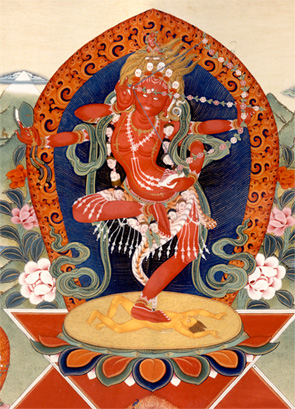Kurukulla: Difference between revisions
Jump to navigation
Jump to search
mNo edit summary |
No edit summary |
||
| Line 1: | Line 1: | ||
[[Image:Kurukulla.jpg|frame|From the visions of [[Jamyang Khyentse Wangpo]]. (Courtesy of [[Dzongsar Jamyang Khyentse Rinpoche]])]] | [[Image:Kurukulla.jpg|frame|From the visions of [[Jamyang Khyentse Wangpo]]. (Courtesy of [[Dzongsar Jamyang Khyentse Rinpoche]])]] | ||
'''Kurukulla''' (Skt. ''kurukullā''; Tib. [[རིག་བྱེད་མ་]], ''rikjéma''; [[Wyl.]] ''rig byed ma'') — a female deity associated with the activity of magnetizing. She is usually depicted as red in colour, in dancing posture and holding a flowery bow and arrow. She is also one of the [[Twenty-One Taras]] mentioned in the ancient [[Tara]] [[tantra]]s. | '''Kurukulla''' (Skt. ''kurukullā''; Tib. [[རིག་བྱེད་མ་]], ''rikjéma''; [[Wyl.]] ''rig byed ma'') — a female deity of the [[Lotus family]], associated with the activity of magnetizing. She is usually depicted as red in colour, in dancing posture and holding a flowery bow and arrow. She is also one of the [[Twenty-One Taras]] mentioned in the ancient [[Tara]] [[tantra]]s. | ||
==External Links== | ==External Links== | ||
Revision as of 20:08, 5 November 2013

Kurukulla (Skt. kurukullā; Tib. རིག་བྱེད་མ་, rikjéma; Wyl. rig byed ma) — a female deity of the Lotus family, associated with the activity of magnetizing. She is usually depicted as red in colour, in dancing posture and holding a flowery bow and arrow. She is also one of the Twenty-One Taras mentioned in the ancient Tara tantras.